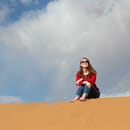On Saturday March 12, my program left in a bus for our week-long village stay in a small, rural village called Tarmilat. I had no idea what to expect the village to be like, and the only information about the host family I would be staying with were their names and ages on a piece of paper. As we left the bustling, flat city of Rabat and drove into the rolling mountains, I saw that Tarmilat was located in one of the most beautiful places on Earth. Throughout the week anytime I got a view of the village or the landscape, it would actually take my breath away. However, the view wasn’t the only thing that was one of my favorite parts of Tarmilat. Here are a couple more:
The view:
Located in the mountains, Tarmilat was a village with rolling green hills that rose up and down like waves in the ocean that had been frozen; skies so blue that you could see the color in the clear rivers, farmland that stretched high onto the hills and disappeared into the endless land beyond, yellow and white daisies scattered across the ground and forming in patches around rocks and water, warm sunshine that hit your face and lit up the grounds and mountains which you could see from there edges of the village which rose high and then abruptly sloped down. At times, when I would sit on a rock out in the sun with a book in my hand, surrounded by a field of white daisies and the sound of a small river running by, I actually felt like I was in the Shire (a place from Lord of The Rings).
The food:
Some of my favorite Moroccan food I’ve had so far has been in Tarmilat. For tea time everyday I had Moroccan crepes called Beghrir. They’re very similar to French crepes expect slightly more spongey and a bit thicker with air holes on the top. Usually Beghrir is served with honey and always, always eaten with your hands. I also had a sandwich at the souk with had steak-cut fries, eggplant slices, onions, and harissa (a hot chili pepper paste) all inside a large piece of Moroccan bread.
The people:
In a village of less than 2,000, you get to know your neighbors pretty quickly, despite how spaced out some of the houses are from each other. I remember how my host family’s four year-old neighbor, Marwa, would come over in the evening to hang out with us and we would end up spending a lot of time (and cellular data) taking photos on Snapchat with her using the different filters which she found heavily amusing. My own host family was absolutely amazing. I had mother, father, thirteen year-old sister, and a nineteen year-old brother. My host mother and I bonded over her attempting to teach me Tamazight (language of the Amazigh people, which my host family were) while my host father and I watched Bollywood dramas together after he would come home from work as I would braid my host sister’s hair and then later watch my host brother zoom around on his bright orange motorcycle, watching the tricks he could do on them and how fast he would go.
The animals:
There were so many animals in the village and since it is a farming village, I wasn’t surprised. I remember watching cows walk nonchalantly across the streets without their owner anywhere in the vicinity yet the cows still knew where they were going. There were sheep that grazed in little herds all of the village as their owners either sat on a rock or the ground, biding their time as their sheep ate. There were dogs and cats that spent the majority of their days outside when the weather was warm, sleeping in a field of daisies or laying outside their owner’s home. Goats that jumped across rocks and walked around like the land was their own. Yet my favorite animal there I saw were the donkeys. You could hear them from a while away, making noises as they carried supplies for their owners or were being rode by them. I made it my mission during the week I was in Tarmilat to pet a donkey since they are one of my favorite animals and on my last full day in the village, I was able to ride and pet the donkey of my host mother’s neighbor.
Stay tuned for more about my amazing experience in Morocco!

